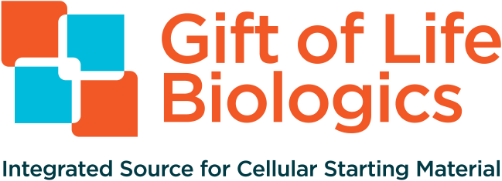How to Thaw Cryopreserved Cells (Vials)
GENERAL INSTRUCTIONS
- Warm the thawing buffer in a 37ºC water bath. Our recommended thawing media is PBS+10% HSA.
- Under aseptic conditions in a BSC, add 10ml of thawing media into a 50ml conical tube.
- Wipe the outside of the vial with 70% ethanol or isopropanol.
- Under aseptic conditions in a BSC, twist the cap ¼ turn to relieve internal pressure, then re-tighten.
- Quickly thaw cells in a 37°C water bath by gently swirling the vial while thawing the product. Thawing must be performed as quickly as possible to improve cell viability and recovery from cryopreservation. Note: it is recommended to transfer the vial to a sealable plastic bag before submerging into the water bath to prevent water going inside the product.
- Remove the vial when a small amount of ice is still visible.
- Wipe the vial with 70% ethanol or isopropanol and transfer to the BSC.
- Remove an appropriate aliquot for cell count and viability according to your internal procedures. Proceed with testing as appropriate.
- Transfer the remaining cells suspension to the 50 ml conical tube containing 10ml of thawing media.
- Rinse the cell vial with 1ml of thawing buffer and add it dropwise to the cells, while gently swirling the 50 ml conical tube.
- Wash the cells by adding 15-20ml of medium dropwise, while swirling the conical tube. Our recommended washing buffer is PBS+0.5% HSA+2Mm EDTA.
- Centrifuge the conical tube at 400g for 10 minutes at room temperature.
- Remove the supernatant and discard.
- Cells are ready for downstream applications.
Important: the count of viable cells must be performed immediately after thawing (before washing) to confirm the count of cells provided.
Reference: Allison Hubel (2018). ‘Preservation of Cells. A practical manual’.
Reference: Allison Hubel (2018). ‘Preservation of Cells. A practical manual’.
DISCLAIMER
The products purchased from Gift of Life Biologics are “For Research Use Only.” In compliance with U.S. Food and Drug Administration (FDA) Regulations, these products are not intended for use in clinical diagnostic procedures nor in therapeutic procedures.
The products purchased from Gift of Life Biologics are “For Research Use Only.” In compliance with U.S. Food and Drug Administration (FDA) Regulations, these products are not intended for use in clinical diagnostic procedures nor in therapeutic procedures.
How to Thaw Cryopreserved Cells (Leukopaks)
GENERAL INSTRUCTIONS
- Warm the thawing buffer in a 37ºC water bath. Our recommended thawing buffer is PBS +10% HSA.
- We recommend thawing only one bag at a time to prevent prolonged exposure to DMSO.
- Wipe the outside of the bag with 70% ethanol or isopropanol.
- Under aseptic conditions in a BSC, transfer the product to a sealable plastic bag and seal the bag before submerging into the water bath to prevent water from going inside the product.
- Quickly thaw cells in a 37°C water bath by gently massaging the bag. Note: Thawing should take 1-2 minutes.
- Remove the bag from the water bath when a small amount of ice is visible.
- Clean the outside of the bag with 70% ethanol, remove the cryobag from the plastic bag and transfer to the BSC.
- Use a syringe to transfer the thawed cells into a 50ml conical tube.
- Dropwise, add an appropriate volume of thawing media to cell suspension.
- Mix well and remove an appropriate aliquot for cell count and viability according to your internal procedures.
- Centrifuge the cell suspension at 400 x g for 10 minutes at room temperature.
- Remove and check the clarity of the supernatant and visibility of a cell pellet.
- Transfer conical tube into BSC. Aspirate the supernatant without disturbing the cell pellet.
- Re-suspend the cell pellet in desired media or washing buffer for further application. Our recommended washing buffer is PBS+0.5% HSA+2mM EDTA.
- Cells are ready for downstream applications.
Important: the count of viable cells must be performed immediately after thawing (before washing) to confirm the count of cells provided.
Reference: Allison Hubel (2018). ‘Preservation of Cells. A practical manual’.
Reference: Allison Hubel (2018). ‘Preservation of Cells. A practical manual’.
DISCLAIMER
The products purchased from Gift of Life Biologics are “For Research Use Only.” In compliance with U.S. Food and Drug Administration (FDA) Regulations, these products are not intended for use in clinical diagnostic procedures nor in therapeutic procedures.
The products purchased from Gift of Life Biologics are “For Research Use Only.” In compliance with U.S. Food and Drug Administration (FDA) Regulations, these products are not intended for use in clinical diagnostic procedures nor in therapeutic procedures.


